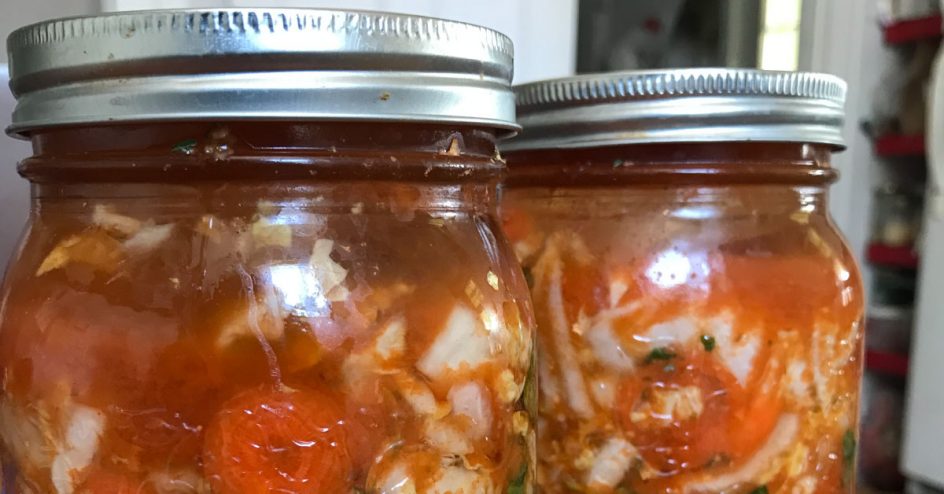Aidan shares her homemade kimchi recipe with you! This is a perfect recipe to learn about rapid fermentation and to enjoy this staple of Korean cuisine.

Kimchi by Aidan
A quick and easy crunchy and tasty kimchi recipe!
Prep Time 30 minutes
Cook Time 15 minutes
Fermenting and resting time 2 days 2 hours
Total Time 2 days 2 hours 45 minutes
Ingredients
Ingredients
- 1.5 kg Napa Cabbage feel free to add other sturdy greens too like kale
- 1/2 cup thinly sliced carrot
- 1/2 cup thinly sliced apple I prefer Granny Smith, but another tart apple will do just fine
- 1 bunch chopped scallions
- 1/2 cup chopped chives
- 50 g sea salt it's really important not to use iodized salt as this won't allow for the fermentation to properly take place
For paste
- 1 cup water
- 1 1/2 tbsp sugar
- 1 medium knob peeled ginger about the size of your thumb
- 1 small yellow onion peeled
- 15 cloves garlic peeled (or two small heads worth)
- 1 tbsp fish sauce optional
- 1 cup gochugaru Korean pepper, see note for where I get mine!
- OR
- 1/2 cup gochugaru
- 1/4 cup gochujang fermented pepper paste This has been a recent addition to my kimchi-making and I absolutely love the sweet complexity it adds to the fermentation 💚
Instructions
-
Start by removing any exterior layers of your cabbage that are scraggly or bruised — and put off to the side (these will serve as top layers later!)
-
Quarter the cabbage, leaving the core intact, and run under cool water; place in your large bowl.
-
In the large bowl salt in between the individual layers of the cabbage as best as possible.
-
Massage the cabbage so that the salt permeates into the skin of the cabbage leaves.
-
This should be repeated every 30 minutes for about 2 hours. This will start to break down the cabbage, and each time you’ll notice that more and more water collects at the bottom of the bowl. Hold onto these juices as they’re key to your fermentation!
-
While waiting on the juices from the cabbage to release you can start on preparing the pepper paste
-
On the stovetop heat water and add sugar, mixing until completely diluted. Let cool.
-
In a food processor or blender add all the ingredients for the paste. Add the sugary water at the end.
-
Feel free to adjust as you see fit, if you’d like to add more ginger, or fish sauce, or spice that’s A-OK! I tend to believe that if your paste is to your liking the same will be true for your kimchi.
-
After 2 hours have passed, remove the cabbage from the bowl, cut out the core, roughly chop the cabbage and place back into the bowl with its juices. Add carrots, apples, scallions, and chives to the bowl.
-
Pour paste over raw ingredients and toss together until the paste coats everything evenly.
-
Add all ingredients to your wide-mouth mason jar. Pack down and add any remaining juices from the bowl into the jar. Leave about 1″ of headspace at the top.
-
Place one or two full-cabbage leaves we trimmed off the head earlier on to the top of the vegetables so as to create a barrier between the ingredients and the air — this ensures that an anaerobic environment forms and that unwanted bacteria won’t form in your kimchi!
-
Cover the jar with a clean dish towel or paper towel, and a rubber band; this ensures nothing gets into the jar, while allowing gases from the fermentation to be released.
-
You also have the option of lightly screwing a lid on top, but this will mean you need to periodically “burp” the jar so that too much CO2 doesn’t build up inside the jar.
-
Set aside on a countertop, away from the sun, or in your pantry for 2 days to allow the fermentation to begin before refrigerating. Flavours will deepen over time, and kimchi will get softer the longer you allow the fermentation to go along for.
-
Note that depending on the temperature in your home, or when in the year you decide to make kimchi the fermentation time can vary. I recommend tasting the kimchi every day or so until it reaches the flavour and texture that you like. I personally prefer my kimchi fermenting for approximately 3 days because I love keeping the crunchy texture of the cabbage.
-
Once it’s reached the flavour and texture profile you like, screw on the lid and store your kimchi in the fridge.
-
Enjoy on rice, with sautéed greens, eggs, or anywhere else you like !
Recipe Notes
It’s important to note that if your cabbage and other leafy greens aren’t the exact weight I mentioned above that’s totally fine, but make sure you adjust your salt quantities to match your raw ingredients.
Simple ratios help determine how much salt to cabbage you need!
Get your Korean Pepper here

